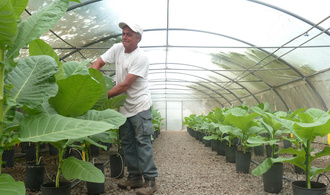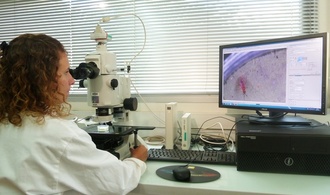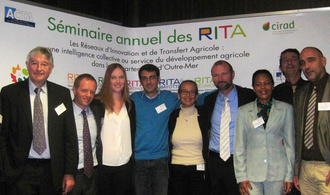RITA - Time to transfer
Written by Modified on the
The results of the Agricultural Innovation and Knowledge Transfer Network ( RITA) at the 2015 Agriculture Fair and its renewal as RITA 2, focusing on knowledge transfer to farmers, is an opportunity for us to speak to Guillaume Insa. The host of RITA Reunion and Technical Director of the Armeflhor[1] talks about the role of Reunion Island in partnerships between agricultural stakeholders in overseas territories.
The creation of RITA
In the 2009 General Overseas Assembly, the various agricultural professionals from French overseas departments were asked about their most pressing needs. According to Guillaume Insa:
“They wanted us to be more responsive to their needs and help them with technical issues. Consequently, the Ministry of Agriculture, CIRAD and ACTA[2] carried out a number of studies and, rather than create a new agricultural organization, they came to the conclusion that there were already enough organizations in the overseas departments, they simply had to be better networked and encouraged to work together.”
Hence, it was decided to create an agricultural Innovation and knowledge transfer network (RITA) for each overseas department. Launched in 2011 by the French Ministry of Agriculture, RITA encourages agricultural diversification in French overseas departments[3]. It brings together partners in agricultural Research, Development and Training, including laboratories, national and up-and-coming technical institutes, chambers of agriculture and other technical agencies and training centers. This is a professional collaboration network which provides a joint response to specific questions such as how to optimize livestock costs, reduce use of chemical inputs or diversify production. It is a true collaborative chain where everyone involved is a specialist in his field. It improves research and benefits producers working in overseas territories.
"RITA aims to support, accelerate and enhance agricultural production and plant/animal diversification in overseas departments through innovations in research and development and, importantly, passes on the benefits to farmers. It encourages networking between R&D professionals, led by the DAAF of each department."[4]
From RITA 1 to RITA 2 – Better dynamics and inter-DOM knowledge transfer
During the 2015 Agricultural Fair, the various partners reviewed the results since the operational implementation of RITA 1 in 2012 and identified guidelines and goals for RITA 2, which began in January 2015.
Whereas RITA 1 placed more importance on applied research, RITA 2 focuses on the transfer of innovation in agro-ecology[5] and its appropriation by farmers since 2012. The goal of RITA 2, as explained by the Technical Director of Armeflhor, is "to ensure that all benefits of applied research and experience is passed on to the farmer.” For this, an essential link in the "RITA" chain is the Chamber of Agriculture of each department. When new techniques are developed, it is the CIRAD and Armeflhor’s job to train technicians, who then pass on the new techniques to producers.
"Everyone has a role to play. At Armeflhor, we are somewhat at the junction between CIRAD’s research and development organizations like the Chamber of Agriculture or producer organizations, we steer the overall approach. But the Chamber and agricultural colleges are responsible for education, not only of farmers and technicians, but also whole organizations.”
A second aim, according to Guillaume Insa, is "to encourage more inter-departmental exchange, to ensure that overseas departments share not only the problems they encounter but also their successes and achievements.” This saves departments from carrying out the same trials done previously by another department.
A biofactory in Reunion
In Reunion Island, this partnership resulted in the 2014 establishment of La Coccinelle biofactory. It produces beneficial insects for greenhouse growers to enable them to reduce the use of chemical inputs and help develop an Integrated Pest Management.[6] "It was the first project approved by RITA in 2012. At the time, professionals needed a complete range of auxiliary insects for our greenhouses. So the Armeflhor, CIRAD and FDGDON[7] gathered around a table. Different roles were attributed: CIRAD worked on studying and understanding the insect, FDGDON on breeding methods, the Armeflhor on the technical trials… it all came together in La Coccinelle (...). We can now see the end product: La Coccinelle is a tool at the service of farmers, selling beneficial insects to farmers… it’s therefore made by farmers for farmers."
Each link in this chain is clear to see: on the research side, CIRAD is in charge of biological component of the insect and carries out laboratory tests on auxiliary insects to determine their adaptability, development and their range of prey. It then passes the baton to the Armeflhor teams for experimentation in greenhouses. Finally, once all testing is complete, auxiliaries are produced in the breeding greenhouses of La Coccinelle. Currently, the biofactory produces Encarsia and Eretmocerus parasitic wasps at the larval stage. They will go on to parasitize white fly larvae, a major tomato pest. These wasps are then packed as platelets which are distributed once or twice a week to greenhouse growers through producers' organizations or technical advisers.
[1] Armeflhor - Association Réunionnaise pour la Modernisation de l’Economie Fruitière, Légumière et HORticole
[2] Cirad - Centre de Coopération Internationale en Recherche Agronomique pour le Développement
ACTA - Réseau des instituts des filières animales et végétales
[3] The RITA leads projects supported by European public funds (POSEI and EAFRD), and state funds. It is through this "filter" organization that overseas projects are being conducted by the Ministry of Agriculture including Ecophyto, Ecoantibio and Ambition Bio.
[4] DAAF - Direction de l’Alimentation, de l’Agriculture et de la Forêt
[5] Agro-ecology is defined by the French Ministry of Agriculture as "the set of practices favoring autonomy for farms and enhancing their competitiveness by maintaining or increasing economic efficiency, improving production and reducing consumption of energy, water, fertilizers, pesticides and veterinary drugs, particularly antibiotics."
[6] Biological Integrated Protection (IBP) is a method of crop protection which focuses on biological means as an alternative to chemical control in the fight against crop pests. It combines two alternative control methods: biological control, based on the use of so-called auxiliary insects, and integrated protection, which combines biological, chemical, physical and crop-related methods.
[7] Fdgdon - Fédération Départementale des Groupements de Défense contre les Organismes Nuisibles





